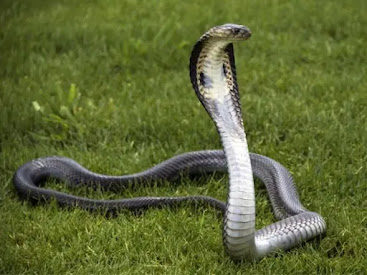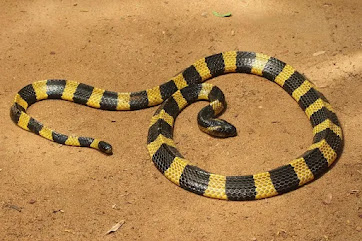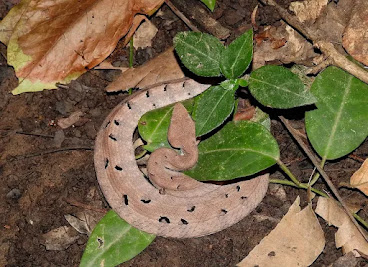Indian
Cobra (Naja naja)
1. Color and Pattern: Indian Cobras typically have a brown, black, or gray coloration with lighter or darker bands along their bodies. Some individuals may also exhibit a hood pattern on the back of their heads, resembling spectacles, hence the name "spectacled cobra."
2. Size: Indian Cobras are medium to large snakes, with adults averaging between 4 to 6 feet (1.2 to 1.8 meters) in length. However, some individuals can grow up to 7 feet (2.1 meters) or more.
3. Habitat: Indian Cobras are found in a variety of habitats, including forests, grasslands, agricultural areas, and urban areas. They are often found near water sources and human habitation.
4. Behavior: Indian Cobras are known for their hooding behavior, where they spread their neck ribs to form a hood when threatened or defensive. They are primarily terrestrial but can climb trees and swim well.
5. Venom: The venom of the Indian Cobra is highly potent and contains neurotoxins that affect the nervous system. A bite from an Indian Cobra can lead to symptoms such as paralysis, respiratory failure, and potentially death if not treated promptly with antivenom.
6. Diet: Indian Cobras primarily feed on rodents, frogs, toads, and other small vertebrates. They are also known to feed on other snakes, including venomous species.
7. Reproduction: Indian Cobras are oviparous, meaning they lay eggs. The female lays a clutch of 10 to 30 eggs in a hidden location, which hatch after an incubation period of about 50 to 60 days.
Monocellate Cobra (Naja
kaouthia)
The Monocellate Cobra, also known as the Monocled Cobra (Naja kaouthia), is a highly venomous snake found in South and Southeast Asia, including the Indian subcontinent. Here are some key features of the Monocellate Cobra:
1. Color and Pattern: The Monocellate Cobra varies in color from brown or gray to olive-green, with a lighter underside. It has a distinctive circular or "monocle" pattern on the back of its hood, which gives it its name.
2. Size: Monocellate Cobras are medium to large snakes, with adults averaging between 4 to 6 feet (1.2 to 1.8 meters) in length. However, some individuals can grow up to 8 feet (2.4 meters) or more.
3. Habitat: Monocellate Cobras are found in a variety of habitats, including forests, grasslands, agricultural areas, and urban areas. They are often found near water sources and human habitation.
4.Behavior: Monocellate Cobras are primarily terrestrial but can climb trees and swim well. They are known for their hooding behavior, where they spread their neck ribs to form a hood when threatened or defensive.
5. Venom: The venom of the Monocellate Cobra is highly potent and contains neurotoxins that affect the nervous system. A bite from a Monocellate Cobra can lead to symptoms such as paralysis, respiratory failure, and potentially death if not treated promptly with antivenom.
6. Diet: Monocellate Cobras primarily feed on rodents, frogs, toads, and other small vertebrates. They are also known to feed on other snakes, including venomous species.
7. Reproduction: Monocellate Cobras are oviparous, meaning they lay eggs. The female lays a clutch of 10 to 20 eggs in a hidden location, which hatch after an incubation period of about 50 to 60 days.
The
King Cobra (Ophiophagus Hannah)
The King Cobra (Ophiophagus hannah) is the world's longest venomous snake, known for its impressive size and distinctive appearance. It is native to forests from India through Southeast Asia. Here are some key features of the King Cobra:
1. Size: Adult King Cobras can grow up to 18 feet (5.5 meters) in length, although they typically range from 10 to 13 feet (3 to 4 meters). They are much larger than other cobra species.
2. Color: King Cobras are usually olive-green, tan, or black in color, with lighter underbellies. They have distinctive black and white bands around their bodies and a black band behind their heads, resembling a crown, giving them their name.
3. Habitat: King Cobras are primarily found in dense forests, rainforests, and areas near bodies of water. They are skilled climbers and are often found in trees.
4. Diet: The King Cobra's diet consists mainly of other snakes, including other venomous species. They are known to eat even other King Cobras. They also consume lizards, birds, and small mammals
5. Venom: King Cobra venom is highly potent and can kill a human with a single bite. However, King Cobras are usually shy and will avoid confrontation with humans. They will only attack if they feel threatened or cornered.
6. Behavior: King Cobras are solitary and are known for their distinctive "hooding" behavior, where they raise the front third of their bodies off the ground and flatten their necks into a hood when threatened
7. Reproduction: King Cobras are oviparous, meaning they lay eggs. They construct nests using leaves and other vegetation, and the female guards the nest until the eggs hatch.
Common Karait (Bungarus caeruleus)
The Common Krait (Bungarus caeruleus) is a highly venomous snake found in the Indian subcontinent. Here are some key features of the Common Krait:
1. Color and Pattern: The Common Krait has a glossy and smooth body, usually black or bluish-black in color, with narrow white bands that run across its body. These bands give it a striped appearance.
2. Size: Common Kraits are relatively small compared to other venomous snakes, typically ranging from 3 to 4 feet (0.9 to 1.2 meters) in length, although some individuals can grow up to 6 feet (1.8 meters).
3. Habitat: Common Kraits are nocturnal and primarily found in rural and agricultural areas, as well as near human settlements. They are often found hiding in dark and damp places, such as under rocks, logs, or debris.
4. Behavior: Common Kraits are known for their docile nature and slow-moving behavior. They are not aggressive and will usually try to avoid confrontation with humans.
5. Venom: Despite their calm demeanor, Common Kraits possess one of the most potent venoms of all snakes in the region. Their venom contains neurotoxins that can lead to paralysis and respiratory failure in humans if not treated promptly.
6. Diet: Common Kraits primarily feed on other snakes, including venomous species such as cobras and vipers. They also consume other small vertebrates, such as rodents and lizards.
7. Reproduction: Common Kraits are oviparous, meaning they lay eggs. The female lays a clutch of 3 to 14 eggs, which hatch after an incubation period of about two months.
Banded Karait (Bungarus
fasciatus)
The Banded Krait (Bungarus fasciatus) is a highly venomous snake found in the Indian subcontinent and Southeast Asia. Here are some key features of the Banded Krait:
1. Color and Pattern: The Banded Krait has a striking appearance, with alternating black and yellow bands that run across its body. The bands are wide and distinct, giving it a banded or striped appearance.
2. Size: Banded Kraits are relatively large snakes, typically ranging from 3 to 4 feet (0.9 to 1.2 meters) in length, although some individuals can grow up to 6 feet (1.8 meters).
3. Habitat: Banded Kraits are nocturnal and are often found in a variety of habitats, including forests, grasslands, and agricultural areas. They are known to hide in burrows, crevices, and under debris during the day.
4. Behavior: Banded Kraits are generally docile and non-aggressive, but they can deliver a highly venomous bite if provoked or threatened. They are known for their smooth and sinuous movements
5. Venom: The venom of the Banded Krait is highly potent and contains neurotoxins that can lead to paralysis and respiratory failure in humans. However, bites are relatively rare due to the snake's shy nature and nocturnal habits.
6. Diet: Banded Kraits primarily feed on other snakes, including venomous species such as cobras and vipers. They also consume other small vertebrates, such as rodents and lizards.
7. Reproduction: Banded Kraits are oviparous, meaning they lay eggs. The female lays a clutch of 3 to 14 eggs, which hatch after an incubation period of about two months.
Slender Coral Snake (Calliophis melanurus)
The Slender Coral Snake (Calliophis melanurus) is a venomous snake found in parts of Southeast Asia, including the Indian subcontinent. Here are some key features of the Slender Coral Snake:
1. Color and Pattern: The Slender Coral Snake has a distinctive color pattern, with alternating bands of red, black, and white or yellow. The bands are typically narrower than those of other coral snake species, giving it a slender appearance.
2. Size: Slender Coral Snakes are relatively small, typically ranging from 1 to 2 feet (30 to 60 centimeters) in length.
3. Habitat: Slender Coral Snakes are often found in forested areas, including rainforests and deciduous forests. They are also known to inhabit agricultural areas and plantations.
4. Behavior: Slender Coral Snakes are shy and elusive, and they are often found hiding under leaf litter, logs, or rocks. They are also nocturnal, meaning they are most active at night.
5. Venom: The venom of the Slender Coral Snake is highly potent and contains neurotoxins that can cause paralysis and respiratory failure in humans. However, bites are relatively rare due to the snake's secretive nature and non-aggressive behavior.
6. Diet: Slender Coral Snakes primarily feed on other snakes, including smaller venomous species. They also consume other small vertebrates, such as lizards and frogs.
7. Reproduction: Slender Coral Snakes are oviparous, meaning they lay eggs. The female lays a clutch of 2 to 5 eggs, which hatch after an incubation period of about two months.
Common Seasnake (Hydrophis platurus)
The Common Sea Snake, or Yellow-bellied Sea Snake (Hydrophis platurus), is a highly venomous snake found in tropical and subtropical waters around the world, including the Indian Ocean and the seas around Southeast Asia. Here are some key features of the Common Sea Snake:
1. Color and Pattern: The Common Sea Snake has a cylindrical body with a flattened tail, which helps it to swim efficiently in water. It is typically black or dark brown on top with a yellow or light-colored underside, giving it its common name.
2. Size: Common Sea Snakes can grow up to 1.5 to 3.3 feet (0.5 to 1 meter) in length, although some individuals can reach lengths of up to 4.9 feet (1.5 meters).
3. Habitat: As their name suggests, Common Sea Snakes are primarily found in the ocean, particularly in coastal waters, coral reefs, and lagoons. They are often found in shallow waters but can also be found at depths of up to 300 feet (90 meters).
4. Behavior: Common Sea Snakes are highly adapted to life in the water and are excellent swimmers. They are air-breathing reptiles and must come to the surface regularly to breathe. They are also ovoviviparous, meaning they give birth to live young.
5. Venom: The venom of the Common Sea Snake is highly toxic, containing neurotoxins that can cause paralysis and respiratory failure in humans. However, they are not aggressive snakes and will usually only bite if provoked or threatened.
6. Diet: Common Sea Snakes primarily feed on fish and other marine animals, including eels and small crustaceans. They are highly adapted to hunting in water, with flattened bodies and paddle-like tails for swimming.
7. Conservation: Common Sea Snakes face threats from habitat destruction, pollution, and accidental capture in fishing nets. Some populations are declining, making conservation efforts important to protect these unique and important marine reptiles.
Russell's Viper (Daboia russelii)
Russell's Viper (Daboia russelii) is one of the most venomous snakes found in the Indian subcontinent. Here are some key features of Russell's Viper:
1. Color and Pattern: Russell's Viper has a thick body with a triangular-shaped head. It typically has a brown or yellowish-brown color with dark brown patches bordered by lighter scales, giving it a distinct appearance.
2. Size: Russell's Viper is a medium to large-sized snake, with adults averaging between 3 to 5 feet (0.9 to 1.5 meters) in length, although some individuals can grow up to 6 feet (1.8 meters) or more.
3. Habitat: Russell's Viper is found in a variety of habitats, including grasslands, shrublands, and agricultural areas. It is also known to inhabit urban areas and is often found near human habitation.
4. Behavior: Russell's Viper is a nocturnal snake, meaning it is most active at night. It is also known to be a relatively aggressive snake and will strike if provoked or threatened.
5. Venom: The venom of Russell's Viper is highly potent and contains a combination of cytotoxic, hemotoxic, and neurotoxic components. A bite from this snake can lead to severe pain, swelling, and tissue damage, as well as potentially fatal effects such as bleeding disorders and kidney failure if not treated promptly.
6. Diet: Russell's Viper primarily feeds on small mammals, such as rodents, as well as birds and reptiles. It is known for its ambush hunting style, where it lies in wait for prey to pass by before striking.
7. Conservation: Russell's Viper is not currently considered threatened or endangered. However, like many snake species, it faces threats from habitat loss, persecution by humans, and road mortality.
Saw-scaled
Viper (Echis carinatus)
The Saw-scaled Viper (Echis carinatus) is a highly venomous snake found in the Indian subcontinent, as well as parts of the Middle East and Africa. Here are some key features of the Saw-scaled Viper
1. Color and Pattern: Saw-scaled Vipers have a rough, keeled appearance, with scales that have a saw-like ridge. They are typically light brown, gray, or reddish-brown in color, with darker, often zigzagging, patterns along their bodies
2. Size: Saw-scaled Vipers are relatively small, typically ranging from 1 to 2 feet (30 to 60 centimeters) in length, although some individuals can grow up to 3 feet (90 centimeters).
3. Habitat: Saw-scaled Vipers are found in a variety of habitats, including deserts, grasslands, and rocky areas. They are often found in sandy or arid environments.
4. Behavior: Saw-scaled Vipers are named for the distinctive sound they make when threatened, caused by rubbing their scales together. They are known to be aggressive snakes and will strike quickly if provoked
5.Venom: The venom of the Saw-scaled Viper is highly potent and contains a combination of cytotoxic, hemotoxic, and neurotoxic components. A bite from this snake can lead to severe pain, swelling, and tissue damage, as well as potentially fatal effects such as bleeding disorders and kidney failure if not treated promptly.
6. Diet: Saw-scaled Vipers primarily feed on small mammals, such as rodents, as well as lizards and other small reptiles. They are ambush predators, lying in wait for prey to pass by before striking.
7. Conservation: Saw-scaled Vipers are not currently considered threatened or endangered. However, like many snake species, they face threats from habitat loss, persecution by humans, and road mortality.
Bamboo
Viper (Trimeresurus gramineus)
The Bamboo Viper, also known as the Pope's Pit Viper (Trimeresurus popeiorum), is a venomous snake found in parts of Southeast Asia, including the Indian subcontinent. Here are some key features of the Bamboo Viper:
1. Color and Pattern: The Bamboo Viper has a striking appearance, with a bright green or yellowish-green coloration. It often has dark markings or spots along its body, which help it blend in with its bamboo forest habitat.
2. Size: Bamboo Vipers are relatively small snakes, typically ranging from 1 to 2 feet (30 to 60 centimeters) in length, although some individuals can grow up to 3 feet (90 centimeters).
3. Habitat: Bamboo Vipers are arboreal snakes, meaning they are often found in trees and bushes. They are commonly found in bamboo forests, where they can easily camouflage themselves among the bamboo shoots.
4. Behavior: Bamboo Vipers are known for their slow and deliberate movements. They are ambush predators, lying in wait for prey to pass by before striking.
5. Venom: The venom of the Bamboo Viper is hemotoxic, meaning it affects the blood and tissues of its prey. While not usually life-threatening to humans, a bite from a Bamboo Viper can cause pain, swelling, and tissue damage.
6. Diet: Bamboo Vipers primarily feed on small mammals, such as rodents, as well as birds and other small vertebrates. They use their venom to immobilize their prey before swallowing it whole.
7. Conservation: Bamboo Vipers are not currently considered threatened or endangered. However, like many snake species, they face threats from habitat loss and fragmentation.
Hump-nosed Viper (Hypnale
hypnale)
The Hump-nosed Viper, also known as the Merrem's Hump-nosed Pit Viper (Hypnale hypnale), is a venomous snake found in South Asia, including the Indian subcontinent. Here are some key features of the Hump-nosed Viper:
1. Color and Pattern: The Hump-nosed Viper has a relatively short and stout body, with a distinctive hump-like scale on its snout. It is typically brown or gray in color, with darker bands or blotches along its body.
2. Size: Hump-nosed Vipers are relatively small snakes, typically ranging from 1 to 2 feet (30 to 60 centimeters) in length, although some individuals can grow up to 2.6 feet (80 centimeters).
3. Habitat: Hump-nosed Vipers are found in a variety of habitats, including forests, grasslands, and rocky areas. They are often found near human habitation and are known to enter homes in search of prey.
4. Behavior: Hump-nosed Vipers are nocturnal snakes, meaning they are most active at night. They are also known to be ambush predators, lying in wait for prey to pass by before striking
5. Venom: The venom of the Hump-nosed Viper is hemotoxic, meaning it affects the blood and tissues of its prey. While not usually life-threatening to humans, a bite from a Hump-nosed Viper can cause pain, swelling, and tissue damage.
6. Diet: Hump-nosed Vipers primarily feed on small mammals, such as rodents, as well as lizards and other small vertebrates. They use their venom to immobilize their prey before swallowing it whole.
7. Conservation: Hump-nosed Vipers are not currently considered threatened or endangered. However, like many snake species, they face threats from habitat loss and fragmentation.
Malabarian
Pit Viper (Trimeresurus malabaricus)
The Malabar Pit Viper (Trimeresurus malabaricus) is a venomous snake found in the Western Ghats of India. Here are some key features of the Malabar Pit Viper:
1. Color and Pattern: The Malabar Pit Viper exhibits a wide range of color variations, including shades of green, yellow, brown, and sometimes even orange. It often has darker markings or patterns along its body, helping it to camouflage in its forest habitat.
2. Size: Malabar Pit Vipers are relatively small to medium-sized snakes, typically ranging from 1.5 to 3 feet (45 to 90 centimeters) in length, although some individuals can grow up to 4 feet (120 centimeters).
3. Habitat: Malabar Pit Vipers are arboreal snakes, meaning they are often found in trees and bushes. They are commonly found in rainforests, moist deciduous forests, and plantations.
4. Behavior: Malabar Pit Vipers are nocturnal snakes, meaning they are most active at night. They are ambush predators, lying in wait for prey to pass by before striking.
5.Venom: The venom of the Malabar Pit Viper is hemotoxic, meaning it affects the blood and tissues of its prey. While not usually life-threatening to humans, a bite from a Malabar Pit Viper can cause pain, swelling, and tissue damage.
6. Diet: Malabar Pit Vipers primarily feed on small mammals, such as rodents, as well as birds and other small vertebrates. They use their venom to immobilize their prey before swallowing it whole.
7. Conservation: Malabar Pit Vipers are not currently considered threatened or endangered. However, like many snake species, they face threats from habitat loss and fragmentation.
Summary
The Indian subcontinent is home to a diverse array of snake species, each with its own unique characteristics and adaptations. Some of the most notable snakes found in the region include the Indian Cobra, a highly venomous snake known for its hooding behavior; the Monocellate Cobra, another venomous species with a distinctive monocle-like pattern on its hood; the Common Krait, a highly venomous snake with a predominantly nocturnal and docile nature; and the Russell's Viper, a highly venomous snake with a characteristic triangular head and brown or yellowish-brown coloration.
Other snakes found in the Indian subcontinent include the Saw-scaled Viper, known for its saw-like scales and potent hemotoxic venom; the Bamboo Viper, a brightly colored arboreal snake found in bamboo forests; the Malabar Pit Viper, known for its varied color patterns and hemotoxic venom; and the Hump-nosed Viper, characterized by a hump-like scale on its snout and a range of brown or gray colorations.
These snakes play important roles in their respective ecosystems, helping to control populations of prey species such as rodents and maintaining ecological balance. However, encounters with these snakes can be dangerous, as many of them are highly venomous and capable of delivering a potentially lethal bite. It is important to exercise caution and seek immediate medical attention if bitten by a snake.








_at_Kakinada_beach_02.jpg)




.jpg)
.jpeg)










6 Comments
Fantastic way of explaining a distinguish topic
ReplyDeleteThanks sir for appreciation
DeleteVery nice
ReplyDeleteVery informative and interesting
ReplyDeleteThanks
DeleteThanks
ReplyDelete